#carbon steel hunting knives
Text
Knives for Commoners
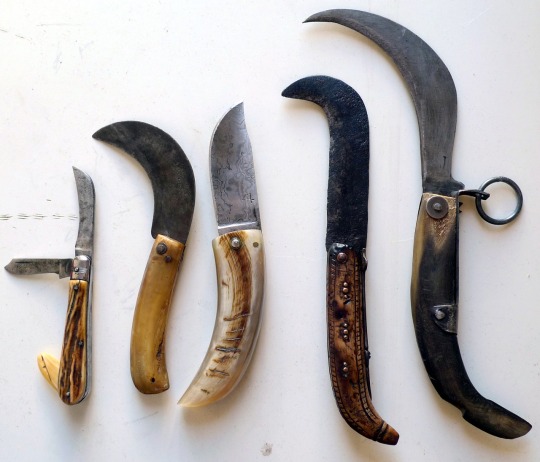
Precious daggers are cool and all, but I’m very fond of simple pocket knives, made to get shit done. So here are a few farmer / peasant knives, ranging from penknife- to sickle-sized.
1. Grafting knife (greffoir) from Thiers, France

This little multi-tool has a curved blade (very used and sharpened, it was originally wider) and a smaller wavy blade. It’s primarily for cutting the stock plant and the plant shoot (or bud) that you mean to graft, though it’s also good for small pruning jobs and general utility. It locks by slipjoint, the standard pocket knife locking mechanism that you’ll find in Swiss army knives. The small flat thing is a bark lifter, it’s made of bone and it’s used for bud grafting: when you insert a bud beneath the bark of a stem, you have to be extra careful to not injure the bark, so you don’t want sharp edges there.
The handle has scales of bone, carved like this in order to look like stag (which is rarer and more expensive). A similar way to accomplish this is “jigged bone” scales, found in a lot of old/classic American and English knives:
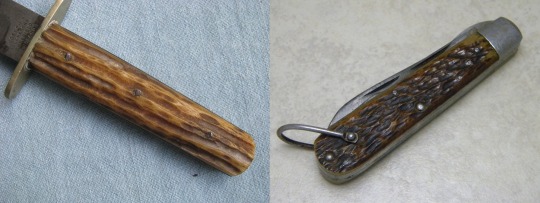
Sheffield hunting knife by Joseph Allen / American folding knife by Camillus
which I honestly think is too... regular, sometimes it looks machine-made even when it’s handmade. But this handle here is sculpted, it’s a work of art, I love it.
Manufactured sometime in *waves vaguely* the 20th century (probably 1930s-1960s) by the cutlery A. Bardin-Dozolmé. The blade is stamped “57 BARDIN Garanti”, which tells us nothing useful, this stamp’s been around since the 18th century. It’s 9.2 cm closed and 14.7 cm open. (3.62 / 5.79 inches)
2. Pruning knife (trinxet) from Mallorca, Spain
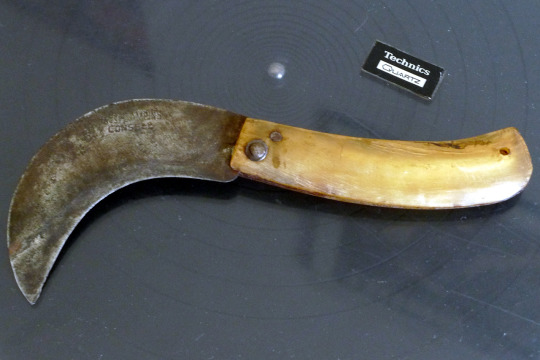
I’ve shown you this before, it’s got a curved carbon steel blade, a horn handle, and “friction lock” as they call it nowadays i.e. no lock whatsoever, it’s a clasp knife. And it’s the simplest, most convenient tool, I adore it.
Made by the cutlery Hermanos Campins in Consell, Mallorca, stamped “HNOS CAMPINS / CONSELL”, mid-20th century, 9.7 cm closed and 17 cm open. (3.82 / 6.7 inches)
3. Shepherd knife (couteau de berger) from Corsica, France
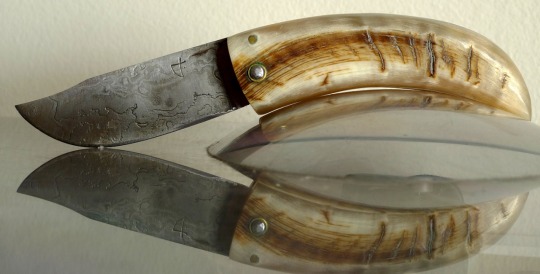
Another clasp knife (doesn’t lock), different shape, with a ram horn handle. Shepherd knives look like utility or bushcraft knives, their blades are not usually curved but they often have a clip-point shape, and they’re quite sturdy.
This is an outlier, it wasn’t really made for work, it’s for tourists or collectors. However, it’s handmade in the tradition of Corsican knife-making (as opposed to the more famous vendetta knives which were manufactured in mainland France, though I should clarify this shape isn’t uniquely Corsican either, it was widespread in both France and Italy), with a couple of modern touches: the blade is forged with a decorative flair, and the horn is first carved at the ridges (to emphasise it’s ram, I’m guessing) and then polished like a mirror.
It’s a strong, solid knife, and absolutely gorgeous.
Made by a local knife-maker (unfortunately I don’t know the name, the blade is signed but with a symbol) in Sartène, Corsica, maybe a decade ago. 11.5 cm closed and 19 cm open. (4.53 / 7.48 inches)
4. Folding billhook (roncola) from Italy


Billhooks are farming tools for cutting and pruning, though usually they have fixed blades. This one isn’t just folding, it’s an actual picklock, like a switchblade. (I mean with the same locking mechanism, it doesn’t open automatically or anything). The blade is carbon steel (that’s a lot of carbon, folks!) and the handle is beautiful, made of carved wood, with brass (I think) insets, and with a fancy external backspring.
Folding billhooks were exported from Italy to the UK. From 1961, a lot of them were imported by Whitby Knives, stamped “Whitby”, and were made in Maniago by Mauro Mario, a prolific knife-maker who also made a ton of switchblades. They looked like this:

The one I got looks earlier to me, but honestly I have no idea when it’s from. Early 20th? Late 19th? *uncertain noises* In any case, it’s 12 cm closed and 22.5 cm open. (4.72 / 8.86 inches)
5. Huge pruning knife (saca tripas) from Guanajuato, Mexico

And last but not least, a big fuck-off pruning knife, which locks securely with a ratchet and unlocks with a pull-ring. This is basically a folding sickle, you reap stuff with it, and can cut thick branches. The very curved carbon blade (it’s not over-sharpened, that’s its original shape) is stamped with a “J”, and the handle is made of horn, with an iron backspring.
The name is extravagantly bloodthirsty, it means “disemboweller” (saca tripas = “pulls out intestines”), and is of course a misnomer: this isn’t a weapon, it’s a farming tool. (Could it be used as a weapon? Well of course, but so can kitchen knives.) I’m not entirely sure if it’s really called that way, or only as a jest, or for the express purpose of selling one of them to bloodthirsty types, i.e. to morons. [Pet peeve: mislabeling work knives as “military” or “fighting” or “tactical”, when they’re clearly for utility, and often for some specific farming job. I even saw an ad for a knife like this describing it as a torture implement, for fuck’s sake people, IT’S FOR CUTTING PLANTS.]
So anyway, these knives can be found all over Mexico, and this one hails from the city of Guanajuato, or at least it was bought there at some point. It’s 16 cm closed and 28.5 cm open. (6.3 / 11.22 inches)
The lot of them
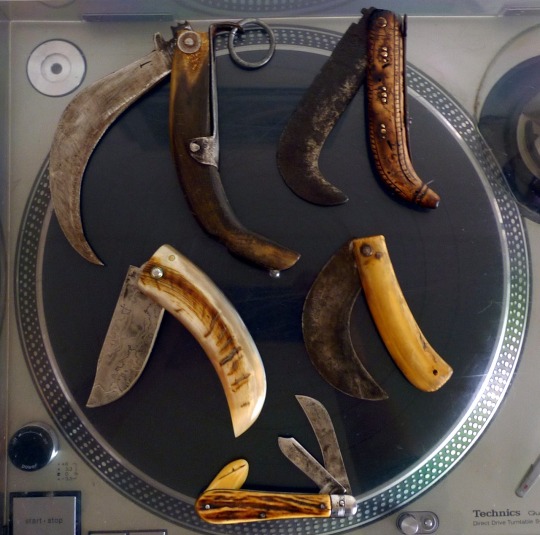
Despite the fact that all these are work knives (except the Corsican, but only technically: it emulates a specific, older work knife, and it’s still 100% functional), a clear effort has been made to make them pretty. And I LOVE this. Even the trinxet, which has a monochrome handle and no frills at all, is elegant in its simplicity, and they all have something going on, carvings, decorations, handles shaped to please the eye, materials chosen for their nice colour.
Aesthetically speaking, I think knives went to shit when plastic was adopted. (Practically speaking, I admit plastic is a lot more resistant to the elements; a handle of horn or bone must be kept dry or it shrivels, wood must be kept from dryness or it shrinks, bugs and mites eat it, it’s a mess.)
Not one blade here is stainless steel, and it shows.
Only the handle of the grafting knife (the smallest one) has scales riveted on a metal frame. Not coincidentally, it’s the most industrial production, it came out of a Thiers factory. (Thiers is a major cutlery centre, like Sheffield and Solingen.) The rest were hand-made in a workshop or at most a cottage industry (a bunch of people in a village construct parts and someone assembles them), and their handles are solid blocks of material (horn or wood), with a slit in the middle to fit the folded blade. That’s the simpler, older construction.
Folding knives are cool.
@tuulikki. And @victoriansword, @petermorwood, @peashooter85, I know you’re into the fancy stuff, but here I am plying humbler wares and hoping. :)
506 notes
·
View notes
Photo

A new Valance Bushcrafter almost ready for the website! 01 carbon steel, dyed maple burl, & copper. redrootblades.com (link in bio) . . . #knife #knives #handmade #carbonsteel #survivalknives #bushcraft #hunting #huntingknife #knifepics #tactical #knifelover #fixedblade #edc #americanmade #usamade #knifepics #kitchenknives #knifemaker (at Crown Point Vista Hose) https://www.instagram.com/p/Cpdzv6JvAXs/?igshid=NGJjMDIxMWI=
#knife#knives#handmade#carbonsteel#survivalknives#bushcraft#hunting#huntingknife#knifepics#tactical#knifelover#fixedblade#edc#americanmade#usamade#kitchenknives#knifemaker
77 notes
·
View notes
Text


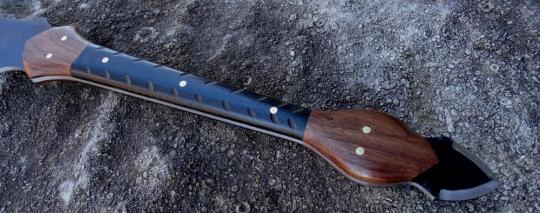
Scorpion – Destroyer Battle Axe
Battle axes have a rich history in warfare & hunting, tracked back to prehistoric times, holding a significant place in culture as a symbol of power and strength. Our Battle Axe is shaped to allow for greater control and precision, making it easier to strike targets. It offers both versatility and double headed striking power in a compact package! Designed by Esteemed Sword Designer Jason Woodard, made by Scorpion Swords & Knives, and is exclusively offered at Kult of Athena, one of the largest most respected sword sellers on the Internet.
The axe is crafted from 1095 high carbon steel which has been expertly tempered to a 57 HRc hardness. It is made as robustly as is possible with its blade and handle tang being made from a single solid piece and is finished with riveted wooden grip scales which are solidly riveted directly to the tough blade tang and overlaid with a leather grip wrap. Included is a leather sheath to complete the sword.
#Kult of Athena#KultOfAthena#New Item Wednesday#Scorpion Swords & Knives#Destroyer Battle Axe#axe#axes#Hatchets & Tomahawks#weapon#weapons#blade#blades#Jason Woodard
2 notes
·
View notes
Text

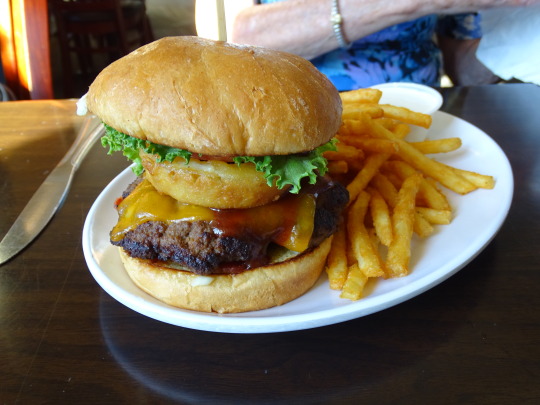






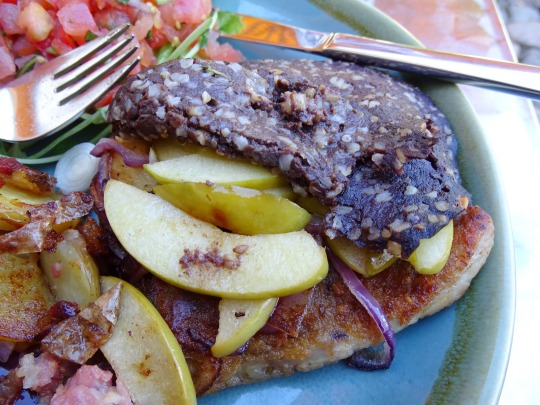
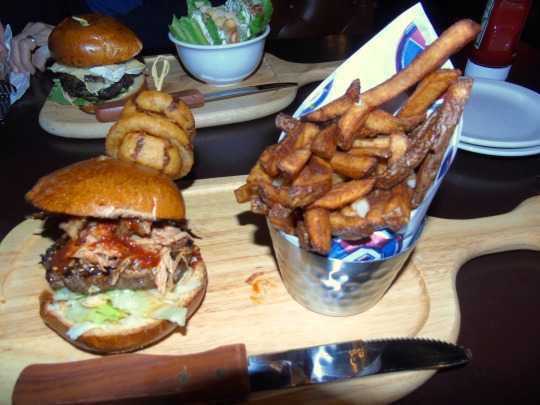

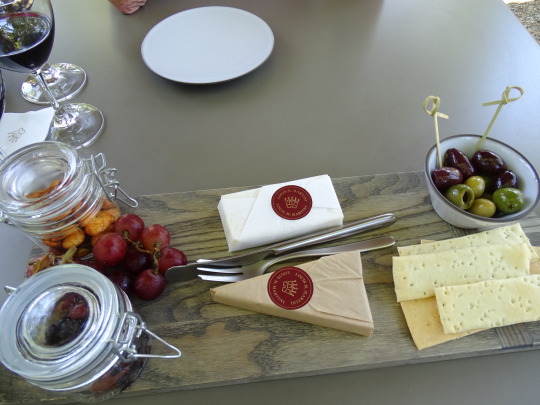
National Knife Day
Grab or pull out your knives! Today we celebrate them, no matter their size, style, or brand! It is unknown who started National Knife Day or when they started it, but it was being celebrated by at least 2011. It is also unknown why the observance takes place on August 24, but one explanation appears to be that the date is connected to the Bowie knife. It was on this date in 1838 that Rezin Bowie, the brother of the knife’s namesake, wrote a letter to the Planters’ Advocate claiming he was the person who had created the knife.
One of the earliest tools known to humankind, the knife was present at the beginnings of the development of human civilization and came out of the need for survival. Early on, knives were used as primitive tools for digging and construction, as weapons, and to hunt, fish, and gather food. In contrast to today, almost everyone carried a knife. The first knives were made of stones which were cracked to make a sharp edge like a blade. Sharpened stone tools became more advanced during the late Lithic periods, and then even more so during the Copper and Bronze Ages. Metal blades appeared, which weren’t as sharp and didn’t stay sharp as long as the stone blades that preceded them. This led to the introduction of sharpening stones.
During the Iron age, tools became stronger and more durable. Iron knives came on the scene and stayed sharper longer. Steel blades followed iron ones, and not much has changed since then. Steel blades, which are made of an alloy of iron that has carbon, are the most common today and are known for being durable and efficient. Cobalt alloys and titanium are also used in knife making today.
Early knives didn’t have a separate handle and blade—they were all one piece. Eventually, handles began being made out of carved bone, wood, and metal, and then, rare materials like mother-of-pearl and tortoiseshell began being used. Today, wood is one of the most popular materials used for knife handles, and metals like stainless steel are also common. One other change besides that advent of a separate handle was the invention of the folding knife.
Knives have many different purposes in the present day, some of which are the same as they have been for thousands of years. Some ways they are used are to prepare food, as a utensil when eating food, by surgeons and medical professionals, to dress an animal, to fillet a fish, and for carving. There are various types of kitchen knives such as the chef’s, utility, paring, and bread knives. Most knives are affordable to just about anyone, but there are high-end custom knives such as Randall Made Knives, most of which sell for $400 of more. In many locations, there are laws that pertain to knives: ownership laws exist for certain types of knives, open and concealed carry laws apply to certain types of knives, and other types of laws exist, such as those that say a robbery is an “aggravated crime” with more severe punishment if a knife is involved. There also are certain areas where some types of knives are not permitted, such as at schools or on planes.
How to Observe
Knives should be used more today than on any other day of the year. Here are a few ideas on how to spend the day:
Do some knife throwing.
Do some whittling.
Prepare some food using a knife or multiple knives. It might be beneficial to first learn what type of knife is appropriate for different types of food.
Get a pocket knife, which has many uses.
Check for knife promotions such as giveaways and sales happening today. This is often a large part of the day.
Give someone a knife as a gift.
Clean, oil, and sharpen your knives.
Carry your knives around in a holster.
Cut a lot of things with your knives, such as food, paper, and rope.
Source
#National Knife Day#USA#Canada#Germany#Schnitzel-Himmel und Erde#food#restaurant#travel#vacation#original photography#Fire Jumper Burger#steak#filet#burger#bread#cookie#NationalKnifeDay#24 August#Jacobs & Co. Steakhouse#Louis M. Martini Winery#St. Francis Winery & Vineyards
2 notes
·
View notes
Text
Selecting the Perfect Hunting Knife: A Comprehensive Guide
A hunting knife is an indispensable tool for outdoor enthusiasts and avid hunters. It serves various purposes, including field dressing game and handling campsite tasks. With a wide array of hunting knives available, choosing the right one can be overwhelming. This blog post provides an in-depth guide to help you make an informed decision by exploring the key factors to consider, such as blade types, handle materials, and other important features.

Blade Types: a. Drop Point: The drop point blade is versatile and suitable for general hunting tasks. It features a curved spine and a durable point, providing excellent control for skinning, slicing, and precise cuts. b. Gut Hook: Designed specifically for field dressing, the gut hook blade has a sharpened hook on the spine. It allows for safe and easy gutting without puncturing the intestines. c. Clip Point: Ideal for detailed tasks like caping, the clip point blade has a concave curve and a sharp point, enabling precise and delicate cuts. d. Skinning Blade: The skinning blade, with its sweeping, curved edge, facilitates efficient hide removal from game animals while minimizing the risk of meat punctures.
Blade Materials: a. Stainless Steel: Stainless steel blades are popular among hunters due to their rust and corrosion resistance, durability, and ease of maintenance. They retain sharpness well. b. High Carbon Steel: High carbon steel blades offer exceptional strength and edge retention, making them suitable for heavy-duty tasks. However, they require regular maintenance to prevent rust. c. Damascus Steel: Damascus steel blades feature beautiful patterns created by layering different steel alloys. They are visually stunning, durable, and sharp.
Handle Materials: a. Wood: Wooden handles provide a traditional and visually appealing look. They offer a comfortable grip but require periodic maintenance to prevent cracking or warping. b. Rubber: Rubber handles provide a secure, non-slip grip, even in wet conditions. They are easy to clean and offer excellent durability and shock absorption. c. G10: Constructed from fiberglass soaked in resin, G10 handles are lightweight, durable, and resistant to moisture and chemicals. They provide a reliable grip in various weather conditions. d. Micarta: Micarta handles are made from layers of resin-soaked linen or paper. They are highly durable, moisture-resistant, and offer a comfortable grip.
Tang Types: a. Full Tang: Full tang knives have blades that extend the entire length of the handle, providing superior strength and balance for heavy-duty tasks. b. Partial Tang: Also known as hidden tang, this design features a blade that does not extend the full length of the handle. Partial tang knives are lighter but may be less robust.
Additional Features: a. Blade Length: Choose a blade length based on your specific needs and preferences. Shorter blades offer maneuverability, while longer blades provide better cutting power. b. Sheath: A quality sheath is essential for safe storage and easy carrying of your hunting knife. Look for a durable, secure sheath that allows for convenient access. c. Blade Edge: Decide between a plain edge or a serrated edge based on your requirements. Plain edges offer precision and ease of sharpening, while serrated edges excel at cutting through tough materials.
Conclusion: Selecting the right hunting knife is crucial for a successful hunting experience. By considering factors such as blade type, materials, handle construction, tang type, and additional features, you can find a hunting knife that suits your needs. Remember to prioritize durability, functionality, and comfort to ensure a reliable tool that will serve you well in the great outdoors. Enjoy your hunting adventures!
2 notes
·
View notes
Text
Unveiling the Essence of Yakut Knives: Craftsmanship, Tradition, and Cultural Heritage
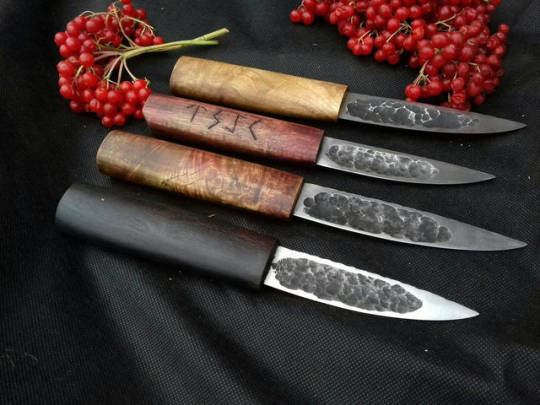
Nestled within the icy embrace of Siberia, amidst a landscape of rugged terrain and pristine wilderness, lies a cultural treasure that embodies the spirit of resilience and tradition—the Yakut knife. For centuries, this iconic blade has been an indispensable tool for the indigenous Yakut people of northeastern Russia, serving as a testament to their ingenuity, craftsmanship, and deep connection to the land. In this article, we embark on a journey to explore the rich history, intricate craftsmanship, and enduring significance of Yakut knives.
A Legacy of Craftsmanship:
The art of Yakut knife-making is steeped in centuries-old traditions passed down from master to apprentice through generations. Skilled artisans, often revered within their communities, devote themselves to the meticulous craft of forging and shaping these exquisite blades. Each knife is a labor of love, meticulously crafted using time-honored techniques and locally sourced materials.
The Blade:
At the heart of every Yakut knife lies its distinctive blade—a testament to both form and function. Crafted from high-carbon steel, the blade is expertly forged to achieve the perfect balance of strength, flexibility, and sharpness. The signature curved shape, reminiscent of a crescent moon, is not merely a stylistic choice but a practical one, allowing for precise slicing and cutting in various tasks, from hunting and fishing to everyday chores.
The Handle:
Equally as important as the blade itself is the handle, which is traditionally made from materials such as birch bark, reindeer antler, bone, or occasionally, exotic woods. The handle is not only functional but also a work of art, often adorned with intricate carvings or inlaid with decorative elements. Beyond its aesthetic appeal, the handle provides a comfortable and secure grip, ensuring optimal control and precision during use.
Cultural Significance:
Beyond its utilitarian function, the Yakut knife holds profound cultural significance within Yakut society. It is more than just a tool; it is a symbol of heritage, identity, and spiritual connection. For the Yakut people, the knife is imbued with symbolic meaning, representing strength, protection, and reverence for nature.
In Yakut folklore and shamanic rituals, the knife plays a central role, serving as a conduit between the physical and spiritual realms. It is believed to possess mystical powers that ward off evil spirits and protect its wielder from harm. As such, the knife is often passed down through generations as a cherished heirloom, carrying with it the wisdom and blessings of ancestors past.
Preserving Tradition:
In an era of rapid modernization and globalization, the art of Yakut knife-making faces numerous challenges. Yet, despite these obstacles, many Yakut artisans remain steadfast in their commitment to preserving their cultural heritage. Through their dedication and passion, they ensure that this ancient craft continues to thrive, passing on their knowledge and skills to future generations.
Conclusion:
In the rugged landscape of Siberia, where the wind whispers secrets of times long past, the Yakut knives stands as a testament to the enduring spirit of a people who have thrived in one of the world's harshest environments. More than just a tool, it is a symbol of craftsmanship, tradition, and cultural identity—a reminder of the resilience and ingenuity of the human spirit. As we marvel at the exquisite beauty and craftsmanship of Yakut knives, let us also pause to reflect on the rich tapestry of history and culture that they represent, weaving together the threads of our shared humanity.
0 notes
Text
Selecting the Right Hunting Knife
Selecting the right hunting knife is a pivotal decision for any hunter, as it can significantly impact the efficiency and enjoyment of your hunting experience. A well-chosen knife serves as an extension of the hunter, capable of performing a variety of tasks from skinning game to cutting through bone. This guide delves into the intricacies of hunting knives, covering types, materials, and essential considerations to ensure you make an informed choice.
Key Takeaways
- Types of Hunting Knives: Understand the differences between fixed blade knives, folding knives, and specialty knives to choose one that best suits your hunting needs.
- Materials and Construction: The choice of blade and handle materials, along with the knife's construction, significantly affects its performance and longevity.
- Choosing the Right Knife: Factors such as the game size, knife ergonomics, blade shape, and edge type are crucial in selecting the perfect hunting knife.
Hunting knives are not just tools; they are companions in the wild that ensure you can efficiently handle the game you harvest. Whether you're a seasoned hunter or new to the sport, knowing the nuances of hunting knife selection can enhance your outdoor adventures.
Types of Hunting Knives
Fixed Blade Knives
Fixed blade knives are the quintessential hunting knives, known for their reliability and strength. With no moving parts, they offer superior durability and are easier to clean, making them ideal for heavy-duty tasks like quartering game or cutting through thick vegetation.
- Pros: Robust construction, easy maintenance, and reliability.
- Cons: Less portable than folding knives, requiring a sheath for safe transport.
Folding Knives
Folding knives are valued for their portability and convenience. They can be easily carried in a pocket, making them a great choice for hunters who prioritize lightweight gear.
- Pros: Compact size, lightweight, and versatile.
- Cons: Generally not as strong as fixed blade knives, more parts mean more potential for failure.
Specialty Knives
Specialty knives, including gut hook knives and skinning knives, are designed for specific tasks. A gut hook knife simplifies the process of opening the abdomen without puncturing internal organs, while skinning knives have a curved blade to efficiently remove the hide.
- Pros: Task-specific design enhances performance for particular jobs.
- Cons: Limited versatility compared to general-purpose hunting knives.
Table 1: Comparison of Hunting Knife Types
Knife Type
Best For
Pros
Cons
Fixed Blade
Heavy-duty tasks, reliability
Durable, easy to clean
Less portable
Folding
Everyday carry, light tasks
Compact, lightweight
Not as strong as fixed blade
Specialty
Specific tasks (skinning, etc.)
Enhanced performance for tasks
Limited versatility
Materials and Construction
Blade Materials
The choice of blade material is critical in determining the knife's performance, especially in terms of sharpness, durability, and corrosion resistance. Stainless steel and carbon steel are the most common materials, each with its advantages.
- Stainless Steel: Known for its resistance to rust and corrosion, making it ideal for hunting in wet conditions.
- Carbon Steel: Offers superior edge retention and is easier to sharpen, but requires more maintenance to prevent rust.
Handle Materials
The handle should provide comfort and a secure grip, even in wet conditions. Materials range from traditional wood to modern synthetics and rubber, each offering different benefits in terms of durability, grip, and aesthetic appeal.
- Wood: Classic and aesthetically pleasing but may require more care.
- Synthetic: Durable and resistant to moisture and temperature changes.
- Rubber: Offers excellent grip, even when wet, but may not be as durable as other materials.
Construction: Full Tang vs. Partial Tang
The tang refers to the extension of the blade that goes into the handle. A full tang design, where the blade material extends through the length of the handle, provides superior strength and balance. In contrast, a partial tang may not offer the same level of durability but can result in a lighter knife.
Table 2: Blade and Handle Materials
Material
Characteristics
Best For
Stainless Steel
Corrosion-resistant, less maintenance
Wet conditions
Carbon Steel
Easy to sharpen, superior edge retention
Precision tasks
Wood
Aesthetic appeal, traditional
Collectors, light use
Synthetic
Durable, moisture-resistant
Rugged, outdoor use
Rubber
Secure grip, even when wet
Skinning, gutting in wet conditions
Selecting and Maintaining Your Hunting Knife
After understanding the types and materials of hunting knives, the next step is selecting the right knife for your needs and knowing how to maintain it. This ensures your knife remains in optimal condition, ready for whatever the wilderness throws your way.
How to Choose a Hunting Knife
Selecting a hunting knife is a personal decision that should be influenced by the type of hunting you do, the game you pursue, and your handling preferences.
Purpose and Game Size
The size and type of game you hunt should guide your knife choice. Larger game like deer or elk require a robust knife that can handle gutting, skinning, and quartering, while smaller game might only necessitate a small, sharp knife for precise cuts.
Comfort and Ergonomics
A knife should feel like an extension of your hand. Pay attention to the handle's shape, material, and the knife's overall balance. A comfortable grip can make all the difference in handling and safety.
Blade Shape and Edge Type
The blade shape affects the knife's versatility. A drop point blade is versatile for both skinning and general purposes, while a clip point offers precision. The edge type, whether straight or serrated, also plays a role in the knife's functionality.
Maintenance and Care
Proper maintenance extends the life of your hunting knife, ensuring it remains sharp, rust-free, and ready for action.
Sharpening Techniques and Tools
A sharp knife is a safe knife. Use a honing stone, sharpening rod, or a knife sharpener designed for your blade type. Regular honing maintains the edge, while less frequent sharpening reshapes it.
Cleaning and Storage
After each use, clean your knife with soap and water, dry it thoroughly, and apply a light coat of oil to the blade to prevent rust. Store your knife in a dry place, ideally in a sheath or case that protects the edge.
Preventing Rust and Corrosion
Stainless steel blades resist rust well, but all knives can benefit from regular maintenance. Keep your knife dry, clean it after use, and apply a protective oil layer to the blade.
Table 3: Knife Maintenance Checklist
Task
Frequency
Tips
Sharpening
As needed
Use the appropriate tool for your blade type
Cleaning
After each use
Dry thoroughly before storing
Oil application
Every 3 months
Use a light oil, avoid excess
Frequently Asked Questions
The best size depends on the game you hunt and your personal preference. A blade length of 3.5 to 5 inches is versatile for most hunting tasks.Sharpen your knife as needed, depending on use. Regular honing after each use keeps the edge sharp, while sharpening may be required a few times per hunting season or after heavy use.Yes, a versatile knife with a drop point blade can be used for both skinning and gutting, but specialized knives may perform each task more efficiently.
Read the full article
0 notes
Text
A Guide to Knife Varieties and Their Many Uses
Knives have been essential tools for humans for millions of years, evolving into a diverse range of shapes and sizes tailored to specific tasks. Whether in the kitchen or outdoors, knives serve indispensable roles. Let's delve into the various types of knives and their versatile uses.
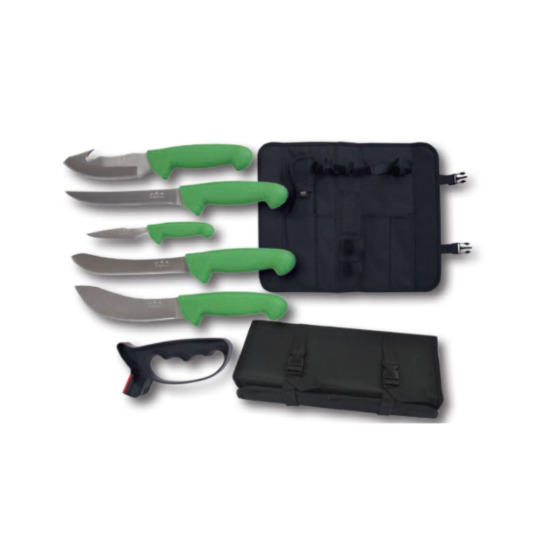
Butcher knives are essential tools for meat processing, featuring wide, curved blades for slicing through meat, tendons, and bone. They include the heavy cleaver for splitting meat and bones, the breaking knife for breaking down large cuts, the boning knife for removing bones, the skinning knife for removing skin, and the scimitar for slicing meat.
There exist several types of butcher knives, each meticulously crafted to fulfill a distinct purpose in the field of butchery:
Cleaver: A hefty, rectangular knife with a thick spine, employed for dividing large cuts of meat and bones. It's also handy for crushing garlic or ginger.
Breaking Knife: Also known as a butcher's knife, it boasts a lengthy, slightly flexible blade perfect for breaking down sizable meat portions into smaller cuts.
Boning Knife: A slender, pointed knife featuring a narrow blade, utilized for extracting bones from meat and poultry.
Skinning Knife: Resembling a boning knife but with a more curved blade, it's crafted for efficiently removing the skin from meat.
Scimitar: A curved, lengthy knife utilized for slicing substantial meat cuts like roasts or steaks.
These knives are crucial for both professional and home kitchens, ensuring efficient and safe meat preparation.

The utility knife is perfect for slicing fruits and vegetables, trimming fat from meats, and cutting sandwiches or small loaves of bread. Its size and sharpness make it a go-to tool for intricate cutting tasks where a larger knife may be too cumbersome.
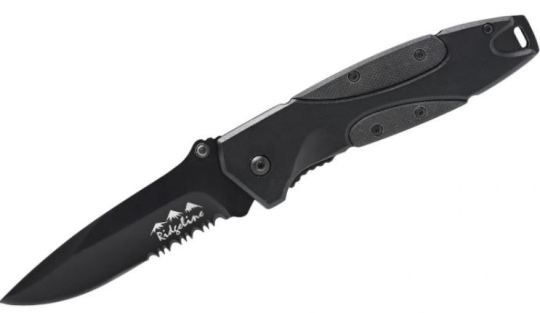
Hunting knives are essential tools for hunters and outdoor enthusiasts, designed for a variety of tasks in the field. These knives typically feature a fixed blade, sturdy construction, and a sharp edge, making them ideal for skinning, gutting, and butchering game. The blade is often crafted from high-quality stainless steel or carbon steel, known for its durability and edge retention.
The handle is designed for a comfortable and secure grip, even in wet or slippery conditions. Some hunting knives also feature a gut hook, a specialized blade for opening the abdomen of game without puncturing the internal organs. With their versatility and durability, hunting knives are invaluable tools for any hunting or outdoor adventure.
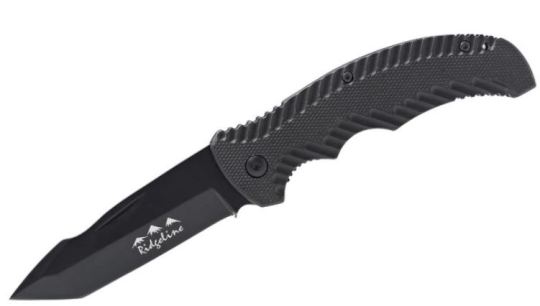
Camping knives are essential tools for outdoor enthusiasts, offering versatility and durability for various tasks in the wilderness. These knives are designed to handle a wide range of cutting tasks, from food preparation to cutting branches for firewood.
Camping knives typically feature a fixed blade for strength and reliability, with a sharp edge that can be used for slicing, chopping, and carving. The blade is often made from stainless steel or carbon steel, known for their ability to hold a sharp edge even after heavy use. The handle is designed to provide a comfortable and secure grip, ensuring safety during use.
Some camping knives also feature additional tools, such as bottle openers, screwdrivers, or saw blades, making them versatile tools for outdoor adventures. With their durability and functionality, camping knives are essential tools for any camping or hiking trip.
Knives are available in various shapes and sizes, each serving a specific function. Whether you are cooking in the kitchen, outdoors, or handling daily tasks, selecting the appropriate knife can significantly impact your efficiency. Therefore, it is important to consider the task at hand before choosing a knife.
1 note
·
View note
Text
What to Look for When Buying a Hunting Knives
Hunting is not only in regards to the chase; it's also in regards to the careful processing of game once it's been harvested. A crucial tool in this method may be the hunting knives. From field to feast, the proper knives will make all the difference in efficiently and effectively preparing your game for consumption. Let's delve into why is a good Hunting knives (Jaktknivar) and explore some top choices for game processing.

Key Features of a Hunting Knives for Game Processing:
Blade Material: Choose a blade crafted from high-quality steel such as for instance metal or carbon steel. These materials offer excellent edge retention and durability, crucial for processing game efficiently.
Blade Design: Choose a knife design fitted to processing tasks, such as a drop point or even a trailing point blade. These designs offer precision and control when skinning, boning, and filleting game.
Handle Comfort: Comfort is paramount during extended use. Pick a knives by having an ergonomic handle created from materials like rubber, wood, or synthetic composites for a protected grip and reduced hand fatigue.
Blade Length: Consider how big is the overall game you typically hunt. A knife amount of 3 to 5 inches is versatile for many game processing tasks, while larger blades might be ideal for big game.
Ease of Maintenance: A hunting knives should really be easy to completely clean and maintain, specially when processing game in the field. Look for knives with corrosion-resistant materials and straightforward designs for hassle-free maintenance.
Top Hunting Knives for Game Processing:
Buck Knives 110 Folding Hunter: This classic folding knives includes a 3.75-inch clip point blade crafted from high-quality stainless steel. Its sturdy construction and time-tested design allow it to be a well liked among hunters for game processing tasks.
Gerber StrongArm Fixed Blade Knives: Built for durability and versatility, the Gerber StrongArm has a 4.8-inch full tang blade produced from high-carbon stainless steel. Its rubberized handle provides a secure grip in just about any conditions, making it ideal for processing game in the field.
Havalon Piranta Edge Folding Knives: The Havalon Piranta Edge is a favorite among hunters because of its razor-sharp replaceable blades. With a lightweight design and a 2.75-inch blade, it excels at precision tasks like skinning and caping game.
Benchmade Hidden Canyon Hunter: Featuring reasonably limited CPM-S30V stainless steel blade and a contoured G-10 handle, the Benchmade Hidden Canyon Hunter is designed for precision and control. Its compact size helps it be perfect for processing small to medium-sized game.

Outdoor Edge RazorLite EDC Folding Knives: The RazorLite EDC stands out because of its innovative replaceable blade system, ensuring a consistently sharp edge for game processing tasks. With a 3.5-inch blade and a light design, it's a versatile option for hunters on the move.
In regards to game processing, having the proper hunting knives can streamline the job and enhance your current hunting experience. By prioritizing key features such as for instance blade material, design, handle comfort, and simple maintenance, you can select a knives that meets your specific needs. Whether you like a traditional folding knives or a modern fixed blade, investing in a quality hunting knives will make certain that you're prepared to show your harvest from field to feast with ease.
please visit the site at roselli.se/collections/jaktknivar to get the more info about Jaktknivar.
0 notes
Text
5 Benefits of Buying Hunting Knives Canada
Hunting knives Canada must not only be durable but should also maintain their edge for as long as possible. Some hunters opt for carbon or Damascus steel blades. These hold an edge more consistently than stainless steel versions despite being more difficult to sharpen.
0 notes
Text
7+1 Classic American Pocket Knives

1) Toothpick, slipjoint folding knife, white plastic scales (shell knife, aka Handle Knife Patent), nickel silver bolsters, slender clip-point blade a.k.a. toothpick (not to be confused with the Arkansas toothpick, which is an ironically named humongous knife). Tang stamp "COLONIAL PAT No. 231064", 11 cm closed, 20th century (mid-20th, maybe?)
2) Fish knife, slipjoint folding knife, cracked marble celluloid handle with a fish-shaped shield, nickel silver bolsters, carbon blades: 1 clip-point and 1 saw/hook-remover/bottle-opener. Tang stamp "Imperial PROV. USA", 12.5 cm closed, c. 1946-1956.
3) TL-29 a.k.a. electricians knife, linerlock folding knife, rosewood handle with brass inset "TL-29" and lanyard ring, nickel silver bolster, brass liners, carbon steel blades: 1 spear-point and 1 wire-stripper/flat screwdriver. The name stands for "Tool, Lineman, number 29", originally from the U.S. Army Signal Corps. Tang stamp on the ricasso "CAMILLUS NEW YORK", and on the blade "TO RELEASE PUSH CENTER LOCK TO LEFT", 9.5 cm closed, circa 1960s.
4) Trapper, slipjoint folding knife, dark red bone (peach seed jig) handle with nickel silver shield "CASE", nickel silver bolsters, brass liners, chrome vanadium carbon blades: 1 clip-point and 1 spey. A Case model #31950 CV. Tang stamp on main blade "CASE XX" and 8 dots for date, and on the spey blade "USA 6254 CV), 10.5 cm closed, 2022.
5) Engineers knife, slipjoint folding knife, jigged bone handle with steel shield "USA" and lanyard ring, steel bolsters and liners, carbon steel blades: 1 spear-point, 1 bottle-opener/flat screwdriver, 1 punch, 1 can-opener. Identical pattern with an ubiquitous camping knife, later adopted for the U.S. Army Engineers. Tang stamp "CAMILLUS CUTLERY CO. CAMILLUS N.Y. USA" (4 lines), 9.3 cm closed, 1942-1945.

6) Buck 110 a.k.a. "Hunter", lockback folding knife, ebony handle, brass bolsters, stainless steel blade. Tang stamp "BUCK 110 USA" and date symbol, 12.3 cm closed, 2018.
7) Barlow, slipjoint folding knife, derlin (synthetic) handle, nickel silver bolster with fancy scroll work, carbon steel blades: 1 clip-point and 1 pen-blade. A Schrade #206, a.k.a. "Grand-dad's barlow". Tang stamp "SCHRADE USA 206", 8.5 cm closed, 1976-1983.
+1) Hunting knife or "Bowie knife", full tang fixed blade knife, jigged bone handle, carbon steel blade. The outlier, neither American nor a pocket knife, but made for the American market and advertised as a "bowie-knife" *, with its iconic clip-point blade. Tang stamp on the ricasso "ALFRED WILLIAMS SHEFFIELD ENGLAND", and on the blade "EBRO" between two Maltese crosses, 22 cm total, circa 1890-1920.

* For collectors, a "bowie" is a knife made for carrying (as opposed to keeping in your kitchen or toolshed), for the American market (regardless of where it was manufactured, the most famous ones are indeed from Sheffield), and somewhat arbitrarily, from 1827 to 1865 (from the Sandbar Fight to the end of the American Civil War). A more generous date range goes to the end of the 19th century, from 1827 to 1900. Everything else is up in the air: it can be big or small, simple or fancy, fixed blade or folding, with a clip-point or dagger or any other blade pattern, and of any materials. Today most people associate the term with a large fixed blade knife with an intense clip-point blade, regardless of when and where it was made.
P.S. I'm missing a stockman knife, and I want very specifically a Case medium stockman with clip, spey and sheepfoot blades, and a nice bone handle (pattern stamp 6318SS).
#tools of the trade#folding knife#knife#bowie knife#trapper#engineers knife#tl-29#trs#sheffield#england#usa#multitool#barlow#trc#trp
14 notes
·
View notes
Photo

Available now! The Mountain Scout in 01 carbon tool steel, English walnut, and brass. Comes with a handmade, veg-tan leather sheath with waxed linen stitching. Find it at —> redrootblades.com (link in bio) . . . #knife #knives #handmade #carbonsteel #survivalknives #bushcraft #hunting #huntingknife #knifepics #tactical #knifelover #fixedblade #edc #americanmade #usamade #knifepics #kitchenknives #knifemaker (at Oxbow Park) https://www.instagram.com/p/CpQOqgbpBkR/?igshid=NGJjMDIxMWI=
#knife#knives#handmade#carbonsteel#survivalknives#bushcraft#hunting#huntingknife#knifepics#tactical#knifelover#fixedblade#edc#americanmade#usamade#kitchenknives#knifemaker
11 notes
·
View notes
Text




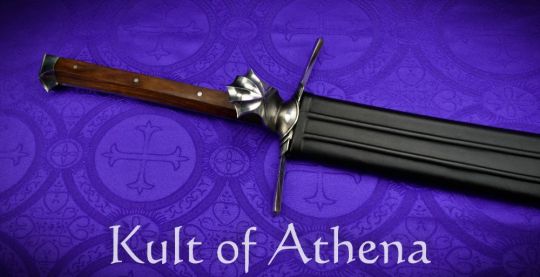
Darksword Armory – The Knochenbrecher Kriegsmesser with Black Scabbard
Weapons of war often evolved from tools used for hunting, farming, or day-to-day survival in a hostile world, and nowhere is that more clear than in the German “Messer” (meaning “knife”) style of swords. Messer swords began as simple, single-edged weapons, merely scaled up versions of the knives from which they descended. Over time, they became distinctive, deadly, and beautiful weapons associated with the Germanic peoples. Darksword Armory’s Knochenbrecher (German for “Bone Breaker”) is based on the Kriegsmesser, meaning “war knife,” the large and imposing weapon of the 15th-century. Large, brutal, and totally battle-ready, the Darksword Armory Knochenbrecher is a powerful cutter – balanced for delivering sweeping, heavy strikes as its historical counterpart would have been.
The Knochenbrecher Kriegsmesser has a tempered blade of 5160 high carbon steel which has been differentially tempered to possess a hardness of 60 HRc at the edge and a hardness of 48-50 HRc at the core. Its guard, nagel and pommel fittings are made from mild steel and the grip halves which are strongly riveted to the blade tang are crafted from hardwood. The hilt has been stoutly constructed with a full tang construction which is further reinforced be peening the tang of the sword over the pommel. Included with the sword is a wood-core scabbard which is bound in black leather and finished with a protective steel chape.
#Kult of Athena#KultOfAthena#New Item Wednesday#Darksword Armory#The Knochenbrecher Kriegsmesser with Black Scabbard#The Knochenbrecher Kriegsmesser#Kriegsmesser#Kriegsmessers#sword#swords#weapon#weapons#blade#blades#European Weapons#European Swords#Medieval Swords#Medieval Weapons#Renaissance Swords#Renaissance Weapons#5160 High Carbon Steel#Battle Ready#new item#new items
7 notes
·
View notes
Text
The Essential Guide to Choosing the Perfect Fixed Blade Knife
The Essential Guide to Choosing the Perfect Fixed Blade Knife
Introduction
Welcome to the essential guide to choosing the perfect fixed blade knife! Whether you are a seasoned outdoors enthusiast or someone looking for a reliable tool for everyday tasks, a fixed blade knife is a must-have. In this guide, we will explore the various factors to consider when selecting the perfect fixed blade knife for your needs.
Understanding Fixed Blade Knives
Fixed blade knives are knives that have a blade that extends directly from the handle and does not fold. They are known for their strength, durability, and versatility. Unlike folding knives, fixed blade knives do not have moving parts, making them more reliable in demanding situations. Consequently, fixed blade knives are popular among hunters, campers, survivalists, and military personnel.
Selecting the Blade Material
The choice of blade material is crucial when selecting a fixed blade knife. Different materials offer varying degrees of durability, sharpness, and corrosion resistance. Common blade materials include stainless steel, carbon steel, and high-carbon stainless steel.
For those seeking a balance between durability and corrosion resistance, stainless steel blades are an excellent choice. They require less maintenance and are less prone to rust. On the other hand, carbon steel blades are known for their exceptional strength and edge retention. However, they require regular care to prevent rust.
If you desire the best of both worlds, high-carbon stainless steel blades combine the strength of carbon steel with the corrosion resistance of stainless steel.
Choosing the Blade Shape
The blade shape plays a significant role in the functionality of a fixed blade knife. Different blade shapes excel in specific tasks.
A drop point blade is one of the most versatile blade shapes, offering a sharp point and a robust edge. It is suitable for a wide range of tasks, including slicing, piercing, and general utility work.
If you frequently engage in hunting or skinning game, a skinning blade with a curved edge is ideal. Its design allows for precise separation of the skin from the meat, minimizing waste.
For heavy-duty tasks such as chopping wood or batoning, a tanto or a clip point blade is preferred. Both blade shapes feature a strong tip and a thick spine, providing excellent strength and durability.
Considering Handle Materials
The handle material is a crucial factor to consider as it determines comfort, grip, and durability. Common handle materials for fixed blade knives include wood, synthetic materials like Micarta, and rubberized grips.
Wooden handles provide a classic and attractive aesthetic. However, they may require maintenance to prevent rotting or warping in moist or humid environments.
Synthetic materials like Micarta or G10 offer excellent grip, durability, and resistance to moisture. They are particularly suitable for outdoor use and for those who prefer a secure hold on their knife.
Rubberized grips provide a comfortable and secure grip, even in wet conditions. They are popular among divers, fishermen, and those who need to use their knife in water-related activities.
Conclusion
Choosing the perfect fixed blade knife is a personal decision that depends on your preferences and intended use. By considering the blade material, blade shape, and handle material, you can find a knife that will serve you well in various situations.
References
fixed blade knife
For more information on fixed blade knives, please check the following websites:
www.knifecenter.com
www.bladehq.com
www.knifeworks.com
0 notes
Text
Cutting Through the Hype: Why a Folding Knife is a Must-Have Everyday Carry Item
Cutting Through the Hype: Why a Folding Knife is a Must-Have Everyday Carry Item Folding knives are an incredibly versatile tool that everyone should consider adding to their everyday carry (EDC) arsenal. Whether you’re a seasoned outdoorsman or someone who just needs a reliable tool for daily tasks, a folding knife is a must-have item. So, what exactly is a folding knife? It’s a knife that has a blade that can be folded into the handle, making it more compact and easier to carry. While some people may think that folding knives are less durable than fixed blade knives, modern folding knives are made with high-quality materials that can withstand a lot of wear and tear. One of the biggest advantages of a folding knife is its portability. Unlike a fixed blade knife, which can be bulky and cumbersome to carry, a folding knife can easily fit into your pocket, backpack, or even on your keychain. This makes it the perfect tool for everyday tasks like cutting open boxes, slicing through rope, or even preparing food. Another advantage of a folding knife is its versatility. Folding knives come in a wide variety of shapes and sizes, with different blade types and materials to choose from. This means that you can find a folding knife that’s perfect for your specific needs, whether you need a knife for camping, hunting, or just everyday use. One popular type of folding knife is the tactical knife. These knives are designed for self-defense and are often used by law enforcement and military personnel. Tactical knives typically have a shorter, thicker blade that can be used for stabbing and piercing, and may also have features like a serrated edge, a point for breaking glass, or even a built-in flashlight. If you’re looking for a folding knife for outdoor activities like camping or hunting, you may want to consider a folding pocket knife. These knives typically have longer, thinner blades that are better suited for cutting and slicing, and may also have additional features like a saw blade, gut hook, or even a built-in firestarter. When it comes to choosing a folding knife, there are a few things to keep in mind. First, you’ll want to consider the blade’s length and shape. A longer blade may be better suited for outdoor activities, while a shorter blade may be more practical for everyday use. You’ll also want to consider the blade material – high-quality stainless steel or carbon steel are both good options. Finally, you’ll want to think about the knife’s handle. Look for a handle that’s comfortable to hold and won’t slip out of your hand, even when wet. A textured or rubberized handle can help with grip, and a locking mechanism can help ensure that the blade stays securely in place. In conclusion, there’s no denying that a folding knife is a must-have item for anyone who wants a reliable and versatile tool that can handle a wide variety of tasks. Whether you’re a hunter, camper, or just someone who needs a knife for everyday use, a folding knife is an excellent choice. So why not add one to your EDC today?
References
folding knives
0 notes
Text
The Essential Guide to Choosing the Perfect Fixed Blade Knife
The Essential Guide to Choosing the Perfect Fixed Blade Knife
Introduction
Welcome to the essential guide to choosing the perfect fixed blade knife! Whether you are a seasoned outdoors enthusiast or someone looking for a reliable tool for everyday tasks, a fixed blade knife is a must-have. In this guide, we will explore the various factors to consider when selecting the perfect fixed blade knife for your needs.
Understanding Fixed Blade Knives
Fixed blade knives are knives that have a blade that extends directly from the handle and does not fold. They are known for their strength, durability, and versatility. Unlike folding knives, fixed blade knives do not have moving parts, making them more reliable in demanding situations. Consequently, fixed blade knives are popular among hunters, campers, survivalists, and military personnel.
Selecting the Blade Material
The choice of blade material is crucial when selecting a fixed blade knife. Different materials offer varying degrees of durability, sharpness, and corrosion resistance. Common blade materials include stainless steel, carbon steel, and high-carbon stainless steel.
For those seeking a balance between durability and corrosion resistance, stainless steel blades are an excellent choice. They require less maintenance and are less prone to rust. On the other hand, carbon steel blades are known for their exceptional strength and edge retention. However, they require regular care to prevent rust.
If you desire the best of both worlds, high-carbon stainless steel blades combine the strength of carbon steel with the corrosion resistance of stainless steel.
Choosing the Blade Shape
The blade shape plays a significant role in the functionality of a fixed blade knife. Different blade shapes excel in specific tasks.
A drop point blade is one of the most versatile blade shapes, offering a sharp point and a robust edge. It is suitable for a wide range of tasks, including slicing, piercing, and general utility work.
If you frequently engage in hunting or skinning game, a skinning blade with a curved edge is ideal. Its design allows for precise separation of the skin from the meat, minimizing waste.
For heavy-duty tasks such as chopping wood or batoning, a tanto or a clip point blade is preferred. Both blade shapes feature a strong tip and a thick spine, providing excellent strength and durability.
Considering Handle Materials
The handle material is a crucial factor to consider as it determines comfort, grip, and durability. Common handle materials for fixed blade knives include wood, synthetic materials like Micarta, and rubberized grips.
Wooden handles provide a classic and attractive aesthetic. However, they may require maintenance to prevent rotting or warping in moist or humid environments.
Synthetic materials like Micarta or G10 offer excellent grip, durability, and resistance to moisture. They are particularly suitable for outdoor use and for those who prefer a secure hold on their knife.
Rubberized grips provide a comfortable and secure grip, even in wet conditions. They are popular among divers, fishermen, and those who need to use their knife in water-related activities.
Conclusion
Choosing the perfect fixed blade knife is a personal decision that depends on your preferences and intended use. By considering the blade material, blade shape, and handle material, you can find a knife that will serve you well in various situations.
References
fixed blade knife
For more information on fixed blade knives, please check the following websites:
www.knifecenter.com
www.bladehq.com
www.knifeworks.com
0 notes